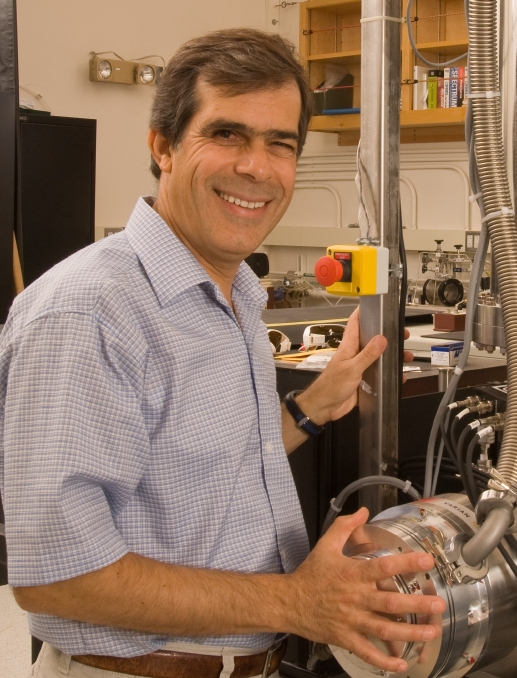
Farid Salama
Astrophysicist
Email: farid.salama@nasa.gov
Professional Biography
During his scientific career, Dr. Salama has pioneered the study of interstellar and planetary molecules in the laboratory in astrophysically relevant environments. Dr. Salama is expert in molecular spectroscopy and does extensive work in the areas of laboratory astrophysics and astrochemistry in conjunction with ultraviolet, optical and infrared astronomy (ground-based, space-based and airborne). He has worked on planetary ices and planetary atmospheres as well as on interstellar carbon molecules and ions in galactic and extragalactic environments. Over the years, Dr. Salama has developed a variety of laboratory facilities to support NASA space missions. He now leads the Cosmic Simulation Chamber facility (COSmIC), a laboratory facility that integrates a variety of state-of-the-art instruments to recreate and monitor simulated space conditions for planetary and interstellar materials in the laboratory. This unique laboratory facility combines the techniques of matrix isolation spectroscopy, cavity ringdown spectroscopy, pulsed discharge nozzle free jet expansion, and Reflectron time-of-flight mass spectrometry in order to produce and to study and characterize interstellar and planetary analogs. The spectra generated in the laboratory are compared with astronomical observations in the ultraviolet, the visible and the infrared obtained from telescopes and space satellites to identify new molecular species in space. Current interests include the study of the physical, chemical, and spectroscopic properties of polycyclic aromatic hydrocarbons (PAHs) and carbon-containing astrophysical analogs relevant to interstellar, cometary, and planetary environments. Much of this work is centered on the study of organic molecules and ions in the interstellar medium (in particular the carriers of the diffuse interstellar bands, the infrared emission bands, and the interstellar extinction), the formation of cosmic grains from molecular precursors and the formation of organic aerosols in the atmosphere of Titan, a moon of Saturn. Recently, efforts have also been applied to the study of lunar dust in support of NASA’s return to the moon
Dr. Salama is the Chair of the American Astronomical Society’s Laboratory Astrophysics Division (AAS/LAD) and the President of Commission B5 (Laboratory Astrophysics) of the International Astronomical Union (IAU). He serves on the Division Steering Committee (DSC) of IAU Division B (Facilities, Technologies, and Data Science) and served on a study group of the 2010 astronomy and astrophysics decadal survey. Dr. Salama manages the NASA’s SBIR topic on In Situ Sensors and Sensor Systems for Lunar and Planetary Science for NASA Ames Research Center and serves on NASA Review Panels. He has served as Guest Editor for Elsevier, Springer, Institute of Physics (IoP) Journal of Physics B and the NASA Scientific and Technical Information (STI) Program. Dr. Salama is a research advisor to the NASA postdoctoral (NPP) and graduate fellowship (GSRP, NESSF, JPFP, NSTRF) programs.
Education
Ph.D. degree in Physical Chemistry, Pierre & Marie Curie University (Paris VI), France, 1986.
Master’s degree in Chemical-Physics, Pierre & Marie Curie University (Paris VI), France, 1983.
Bachelor’s degree in Chemical-Physics, University of Paris-Sud (Paris XI), Orsay, France, 1981.
Research Interests
Astrophysics, Astrochemistry, Astrobiology, Astronomy, Space Missions, Laboratory Astrophysics, Spectroscopy, Interstellar Medium, Planetary Science
Select Publications
https://scholar.google.com/citations?user=Bi4z0EcAAAAJ&hl=en
Awards
NASA Exceptional Scientific Achievement Medal – 2003
Fellow of the American Physical Society – 2014
NASA Hubble 25th Anniversary Commendation – 2016
NASA Space Flight Awareness Team Award – 2014
NASA Group Achievement Award – 2013
NASA Group Achievement Award – 2002
NASA Ames Space Science Division Recognition Award for Outstanding Achievement – 1997
Fellow of the NAS-Alexander von Humboldt Foundation German-American Academic Council – 1996
NASA Ames Space Science Division Recognition Award for Outstanding Achievement – 1992
National Research Council Research Associateship – 1988
Fellow of the Foundation of France – 1985
Fellow of the General Delegation for Scientific and Technical Research, France – 1983



























